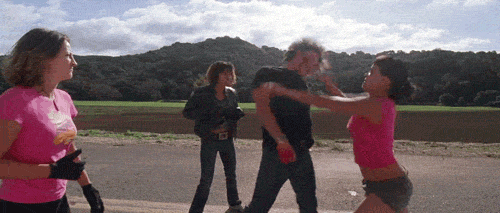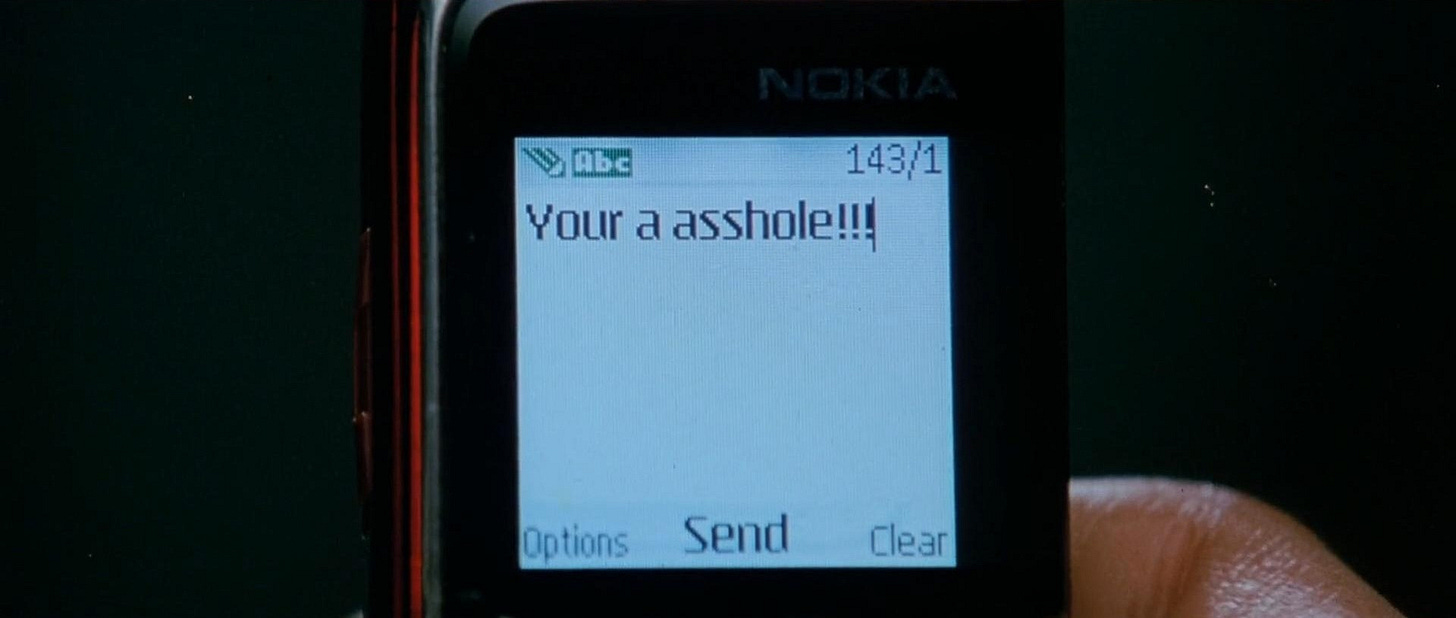Towards the end of Death Proof, before the movie kicks into literal overdrive with a 30-minute car chase, I was struck by a moment of blandness. As two women, one a stunt driver and the other a stuntwoman, talk about the dangerous car game they want to play, the scenery behind them couldn’t be more abrasively dull.
A simple green field dotted with pumpkins? In a Quentin Tarantino car chase horror movie?
It’s no secret that Death Proof flopped at the box office and is somewhat of a regret for its notorious “I’m only making 10 movies because Legacy” director. When I rewatched it this time, I noticed the unintended cracks. I noticed the pumpkins!
I think things like this stand out now because Death Proof was the last film Tarantino made before he himself went into overdrive. He has followed it up with three revisionist historical epics (Inglourious Basterds, Django Unchained, Once Upon a Time in Hollywood) and a slow-burning, still Panavision-shot Western chamber drama (The Hateful Eight).
These films, no matter their quality, are big. They’re big not just in narrative scope, but in their ornate, fetishistic attention to period detail. One of the things that makes Once Upon a Time in Hollywood so seductive and ultimately moving is the obsessive impulse to not just get late ‘60s Hollywood right, but to luxuriate in it; the way it must have felt to move through that world at that time as those people.
Death Proof, by contrast, seems shot on the fly. As with Jackie Brown, Tarantino isn’t trying to fully construct a world, but to project onto the real one. In this case, the projection is an amalgam of his own meandering, dialogue-heavy style and the crackly, unapologetically strewn-together feel of ‘70s grindhouse exploitation films.
Part of the reason Death Proof didn’t perform well at the box office is because it was conceived as a double bill with Robert Rodriguez’s Planet Terror. They were released together as Grindhouse, a 3+ hour homage to an all-but-forgotten slice of horror cinema complete with fake movie trailers. The two films share some of the same actors and locations, and they both intentionally insert abrupt skips during scenes, as if the film print we are watching is scratched.
I’ve had no desire to revisit Planet Terror since the late 2000s, but I return to Death Proof every few years. There’s a distinct charm to watching a good director work within self-imposed parameters like this; to pay tribute to defining movie moments of his youth while leaving his own self-aware, structurally strange imprint on it.1
Tarantino’s film is a bifurcated parable about two groups of women being stalked by a deranged stuntman (Kurt Russell) who orchestrates fatal car crashes with his so-called “death proof” 1969 Dodge Charger. While the movie’s grand finale erupts in the kind of metal-on-metal action that its premise would indicate, until then it is a typically (and entertainingly) chatty Tarantino affair.
“The woods are lovely, dark, and deep. And I have promises to keep, and miles to go before I sleep. Did you hear me, Butterfly? Miles to go, before you sleep.”- Stuntman Mike, Death Proof
Death Proof’s first half chronicles a ladies’ night out in Austin, Texas, for three recently reunited, lifelong friends: locals Shanna (Jordan Ladd) and radio DJ Jungle Julia (Sydney Tamiia Poitier, yes, his daughter) and out-of-towner Arlene (Vanessa Ferlito).
This stretch is set in and around the city’s nooks and crannies, primarily the Mexican restaurant Güero's Taco Bar and the dive bar Texas Chili Parlor. Their names are announced as locals would probably say them: As simply ‘Güero's’ and ‘The Chili Parlor.’
Güero's has unassuming wooden tables, old brick walls, and vintage movie posters (no doubt a Tarantino addition) displayed around the restaurant. The Chili Parlor, as with any dive worth a damn, has gaudy neon alcohol displays and pithy signs like ‘Reserved for Clergy’ dotting its walls. It also has a vintage jukebox with an eclectic selection of oldies. (Knowing the jukebox is owned by Tarantino himself is no surprise, and neither is the writer/director having a woman say its selection is “pretty impressive” before performing a lap dance).
While the exteriors for both places are used in the film, the scenes at The Chili Parlor were shot at an exact replica of its interior.2 It’s hard to imagine the Tarantino of the present going to such lengths to capture a location as it exists now.
But crucially, these locations already feel frozen in time. Their stubbornly well-worn, unpretentious atmospheres are a middle finger to sleeker, newer locales that cater to outsiders and tourists.
This kind of aesthetic nostalgia is a defining marker of Tarantino’s work, but in Death Proof he is searching for it in the modern world rather than creating it from his mind’s eye. And when he finds it, he wants his characters to enjoy it, even if they must text.
Keep reading with a 7-day free trial
Subscribe to The Normal Newsletter to keep reading this post and get 7 days of free access to the full post archives.






